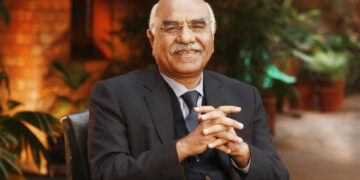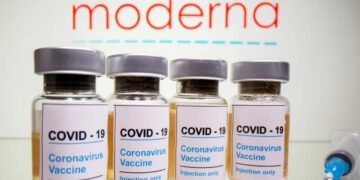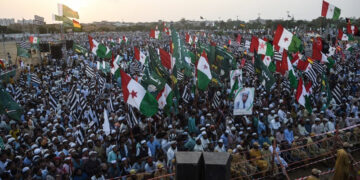
The next government at the Centre would be a coalition led either by the Pakistan People’s Party (PPP) or Pakistan Muslim League-Nawaz (PML-N, with no chance for a third party to emerge as an alternative, notwithstanding the boastful claims of sweeping the May 11elections in a ‘tsunami’.
In most likelihood, it will be the PML-N, with the support of rightist and religious parties in Punjab, nationalist elements in Balochistan and anti-PPP forces in Sindh, which will form the next government at the Centre and in Punjab. This conclusion is based upon the aggregate estimate of results of various national and foreign opinion polls held so far and detailed electronic and print media reports from electoral constituencies from across the country. There are three solid reasons that lend strong support to this view.
First, the PML-N was not able to realise its full electoral potential in the last two elections, i.e. 2002 and 2008 as its leadership, like that of the PPP, was seriously handicapped for being in exile during the 2002 elections and on the eve of the 2008 elections, it was not given sufficient time to finalise its candidates and carry out election campaigns in various parts of the country, including Punjab. The people still remember the humiliating treatment meted out to the former prime minister Nawaz Sharif at the Islamabad airport on his abortive bid to return before the 2008 elections.
Had there not been a sympathy wave for the PPP created by the assassination of Benazir Bhutto, the PML-N’s tally not only in Punjab but also in other parts of the country, except rural Sindh, would have been much larger than 62 out of 272 contested general seats of the National Assembly. There is a feeling among the people, particularly in Punjab, that the PML-N was not given an equal and fair chance to participate in the last two elections with full preparation and homework. In the 2002 elections, which the party contested without the top leadership leading it, the PML-N was at fourth position with 18 NA seats after the Pakistan Muslim League-Quaid’s (PML-Q’s) 118, the PPP’s 80 and the Muttahida Majlis-e-Amal’s 59. In the 2008 elections, the PML-N improved its position, occupying second position with 71 NA seats after the PPP’s 97.
The PML-Q was able to get 42 seats. There is a strong possibility of the PML-N bagging 100 plus seats in the 2013 election to be able to form a coalition government at the Centre with the support of nationalists from Balochistan, the Pakistan Muslim League-Fazl and those elected from the platform of religious parties and sectarian groups. As the prospects of the PML-N’s forming a ruling coalition at the Centre become brighter, a majority of those elected as independents would join it.
Second, the PML-N has strengthened its credentials as a reliable and dependable political party through its consistent and firm position on important issues of foreign and internal policies of the country. Take for example the issue of civil-military relations in Pakistan. No other political party, not even the PPP, which used to enjoy the reputation of being an ant-establishment party, has taken such a bold stand on supporting civilian control over the military in accordance with the constitution. Read the contents of the PML-N petition in Zafar Ali Shah vs Chief of the Army Staff (200) in the Supreme Court; it has constantly maintained its strong opposition to the military’s interference in politics.
This has earned it respect and support from the anti-establishment elements in Sindh and Balochistan. Just as Nawaz Sharif’s support to the Baloch nationalists on the dissolution of the Balochistan Assembly in December 1988 raised his stature from a provincial leader to a national leader challenging the PPP, in the same way his outreach to the Baloch nationalists much before the elections is sure to pay him critical dividends in the post-election exercise of assembling allies for a coalition government. In rural Sindh, although the 10-party alliance is not going to cause any significant dent in the armour of the PPP’s popularity, the PML-N’s alliance with the PML-F and Arbab Ghulam Rahim will enable it to get the support of a few badly needed allies for a coalition at the Centre.
Third, despite non-stop electioneering, Imran Khan’s Pakistan Tehreek-i-Insaf (PTI) has not been able to weaken the PML-N’s grip over Punjab, and the largest province of Pakistan with more than half of the share of the 272 contested National Assembly seats still remains the stronghold of the Sharif brothers thanks to the mistakes committed by the PPP during its last five-year rule. The PPP’s seat adjustment with the PML-Q has not benefitted the former. It has rather gone to the advantage of the PML-N, as for example, in the district of Gujrat.
The PML-N’s position in the province has also been buttressed by the support that it continues to get from the business and trading community. Under a well-thought out strategic plan, the PML-N has followed a policy of concentrating on its traditional areas of influence as well as on permanent sources of support in Punjab by selecting electable candidates in northern and southern Punjab and by reinforcing ties with the business community and middle classes. Though an ideal law and order situation did not prevail in Punjab, governance in Punjab was much better under chief minister Shahbaz Sharif as compared to the other provinces of the country. By executing development plans under his personal supervision and in record time, he has earned the reputation of being a doer.
Despite that, the PML-N’s gains this time in Lahore may be less as compared to the last elections because of a tough challenge from the PTI. Though the PML-N sources claim to be able to capture all the 13 NA seats in Lahore, its tally may fall between eight and nine, with the PPP, PTI and Jamaat-i-Islami (JI) getting one each out of a total of 13 seats in the provincial metropolis.
There is another important development that may help the PML-N in increasing its 2013 election tally. This is the failure of religious parties to contest elections under a single election symbol. For the first time since the 1970 elections, the JI is contesting national elections on individual basis with its own symbol. With religious parties being in total disarray, the PML-N offers the only alternative to their sympathisers as a right-of-the-centre party.
Although the PML-N faces heavy odds in the 2013 elections under the two-pronged attack from the PPP-PML-Q combine and PTI, it is likely to concede not more than one-third of the total 148 National Assembly seats in Punjab to its opponents, including the JI. The main asset of the PML-N is the personal appeal of its top leadership and determined efforts of its middle-rank leaders and workers to reach and win over the silent majority of voters, who are not showing up in election rallies but carefully weighing their preferences and are most likely to vote for the PML-N. – DailyTimes












